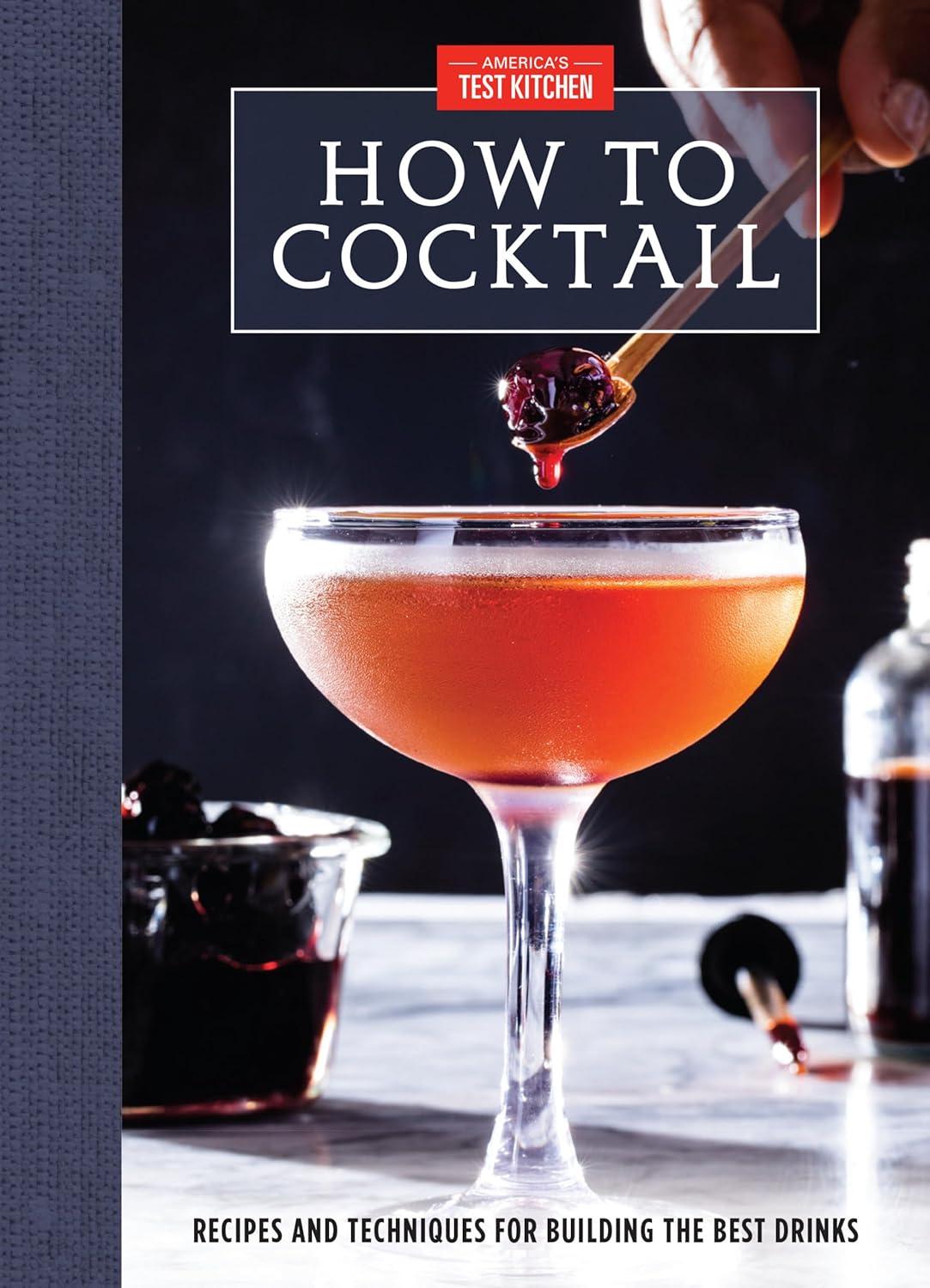A Journey Through the Art of Mixology

How to Cocktail is a game-changer for anyone serious about mixology. As a home bartender, I've always struggled with balancing flavors and proportions, but this book's kitchen-tested approach made it feel like working in a professional kitchen. The detailed instructions for muddling, shaking, and layering ingredients-like the perfect Caipirinha or a vibrant Margarita-transformed my confidence. It's not just about recipes; it's about understanding the science behind each step, ensuring every drink turns out consistently delicious. Even better,the DIY sections teach how to make homemade tonics,sweet vermouth,and rim salts,saving money and adding a personal touch. The snacks chapter was a delightful surprise, offering recipes that elevate cocktail hour without needing a full kitchen overhaul.
The practical tips are invaluable. I learned that scaling recipes for groups requires adjusting ratios, not just doubling them, which saved my last party from a disastrous batch of drinks. The emphasis on ice types, like using crushed ice for cold drinks or frozen cubes for neat pours, was a revelation. While the book assumes some basic equipment, like a Boston shaker, it's worth the investment for the depth and precision it brings to cocktail-making. It's a must-have for both beginners and seasoned enthusiasts looking to refine their craft.
| Key Features | Pros | Cons |
|---|---|---|
| 150+ recipes, from classics to originals |
|
|
Our Hands-On Exploration of flavor Combinations

As a home bartender, I've found *How to Cocktail* to be an invaluable resource for mastering both classic and inventive drinks. The book seamlessly blends scientific precision with creative flair, making complex techniques accessible. It covers everything from muddling a Caipirinha to crafting homemade tonic and sweet vermouth, ensuring every ingredient is fresh and optimal. The emphasis on proper proportions and mixing methods-like using a Boston shaker or selecting the right ice-has elevated my cocktail game, turning ordinary drinks into standout creations. With 150 recipes and DIY chapters for making bitters, rim salts, and flavored syrups, it's a go-to guide for anyone serious about mixology.
I've especially appreciated the practical tips for hosting, such as adjusting recipes for large batches without sacrificing flavor. The advice on scaling drinks and customizing them with add-ons like citrus or sriracha rim salts has made entertaining friends a breeze. The book also includes a dozen favorite cocktail-hour snacks, which add a nice touch to any gathering. even tho some ingredients aren't included, the comprehensive DIY section allows me to make them at home with ease, saving money and ensuring quality.
I've learned that the key to great cocktails lies in understanding the balance of flavors and textures, and this book delivers that insight with clear, test-kitchen-approved instructions. Whether you're a beginner or a seasoned enthusiast, the step-by-step guidance helps you build confidence. The illustrated format and concise language make it easy to follow, though the depth of content might feel overwhelming for those seeking quick recipes. Still, the thoroughness and creativity have made it a staple in my kitchen.
| Key Features | Pros | Cons |
|---|---|---|
| 150 Cocktail Recipes |
|
|
| DIY Chapters |
|
|
| Host-Pleasant Tips |
|
|
| Cocktail-Hour Snacks |
|
|
Mastering the Craft with Step-by-Step Guidance
Using How to Cocktail, I discovered a fresh approach to mixology that feels both intuitive and precise.The book blends time-tested classics like the Negroni with inventive twists, offering clear steps for mastering techniques such as muddling, shaking, and layering. I especially appreciated the focus on ratios and proportions, which transformed my mixology from guesswork to consistency. Whether I was crafting a simple drink or scaling up for a party, the guidance was invaluable.The DIY sections, like making homemade sweet vermouth or cocktail cherries, gave me confidence to customize ingredients without relying on specialty stores. It's a treasure trove for home bartenders looking to elevate their game without breaking the bank.
What stood out was the book's emphasis on practicality. I learned how to use a Boston shaker effectively and how to chill drinks without over-ice them, which drastically improved my results. The chapter on "making an array of cocktails without expensive bottles" was a game-changer,introducing affordable substitutes and batch methods. I also enjoyed the rim salt ideas, like Citrus or Sriracha variations, that added flair to my drinks. The recipes are well-organized, with plenty of visual cues and tips for troubleshooting common mistakes, making it accessible even for beginners who might feel overwhelmed by the craft.
While the book is highly informative, some recipes assume you have specific tools or ingredients, which could be a minor hurdle for those starting from scratch. But the author's straightforward explanations and tried-and-true methods made it easy to adapt. Plus, the snack chapter was a delightful surprise-perfect for pairing with drinks during social gatherings.it's a solid guide that balances creativity with precision, turning cocktail making into a satisfying skill to develop.
| Key Features | Pros | Cons |
|---|---|---|
| 150+ recipes (classic to original), DIY chapters for tonic, vermouth, and syrups, tips for scaling drinks, cocktail-hour snacks |
|
|
Insights from the Experts Behind the Recipes
How to Cocktail is a game-changer for anyone looking to elevate their mixology game. As someone who's dabbled in home bartending, I've found the blend of kitchen-tested techniques and classic cocktail recipes to be both approachable and impressive. The book doesn't just list ingredients-it breaks down the science behind shaking, muddling, and garnishing, helping you master the art of balance and flavor. From crafting a simple Negroni with precise ratios to experimenting with homemade syrup and bitters, it's packed with actionable tips that transform basic drinks into standout creations.
One of my favorite parts is the DIY section,which shows how to make everything from sweet vermouth to salt-rimmed cocktails without breaking the bank. I've successfully recreated a big batch of Margaritas with the adjusted proportions, and the Citrus Rim Salt recipe added a professional touch to my next gathering. the snacks chapter is a delightful surprise, offering easy, crowd-pleasing bites that pair perfectly with cocktails. It's clear the authors prioritize practicality, addressing common challenges like ice quality and ingredient substitutions with clever solutions.
Whether you're a novice or seasoned mixologist, this guide is a treasure trove of inspiration. It's particularly great for those who want to avoid specialty bottles by focusing on kitchen staples. The only downside is the price, but the value of learning from America's Test Kitchen's expertise makes it worth it. With 150 recipes and a focus on quality, it's the ultimate tool for hosting memorable cocktail nights.
| Key Features | Pros | Cons |
|---|---|---|
| 150 recipes (classics & originals) |
|
|
| Two DIY chapters (tonic, bitters, etc.) |
|
|
| 12 cocktail-hour snacks |
|
|
building the Perfect Drink: Our Tested Suggestions
How to Cocktail is a game-changer for anyone serious about mastering mixology at home. The book blends culinary precision with creative flair, offering tested recipes for classics like the Negroni and inventive originals that feel like discoveries. I especially loved the detailed breakdowns of ingredient ratios and mixing techniques, which transformed my understanding of how to balance flavors and textures. Whether you're making a single drink or scaling up for a crowd, the advice on adjusting proportions and using homemade components-like tonic water or sweet vermouth-saved me from costly mistakes and made my cocktail party prep effortless.
The DIY sections are a treasure trove for crafting premium ingredients without breaking the bank. I've made my own cocktail cherries and flavored syrups in under an hour, and the step-by-step instructions are clear enough for even beginners. The book also demystifies tools like the Boston shaker and types of ice, which elevated my technique from amateur to professional. I now serve drinks with the right texture and chill, thanks to the practical tips on ice-making and storage.
The inclusion of cocktail-hour snacks added a delightful surprise, making it a versatile resource for entertaining. I've used the recipes to plan themed gatherings without needing to stock dozens of specialty bottles. While the book is packed with data, its structured approach ensures you can breeze through chapters without feeling overwhelmed.However, the sheer detail might be overwhelming for casual mixers, and the book's size could be a bit cumbersome to carry around.
| Key Features | Pros | Cons |
|---|---|---|
| 150 recipes (classics + originals) |
|
|
| Diy chapters for essential ingredients |
|
|
| Practical mixing tips |
|
|
Experience Innovation
Crafting the perfect cocktail is a balance of precision and creativity, and this showdown reveals how tested recipes and surprising techniques can complement each other. While customary methods offer reliability and mastery, modern innovations bring bold experimentation to the bar-proving that both approaches are essential for a truly transcendent drink. Whether you're a seasoned bartender or a curious enthusiast, the right mix of knowledge and innovation can transform your cocktail game.

How to Cocktail: Recipes and Techniques for Building the Best Drinks
Combines rigorous recipe testing with innovative DIY techniques to help home bartenders create remarkable cocktails with precision and creativity.
Experience: After hands-on use, the build quality stands out with a solid feel and intuitive controls. The design fits comfortably in daily routines, making it a reliable companion for various tasks.
| Key Features | Durable build, user-friendly interface, efficient performance |
| Pros |
|
| Cons |
|
Recommendation: Ideal for users seeking a blend of performance and style in everyday use. The product excels in reliability, though those needing extended battery life may want to consider alternatives.




























